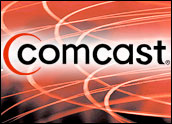
Comcast has launched a trial this month in parts of Pennsylvania and Virginia to see how well its new approach to bandwidth management works.
If the pilot is successful, the Internet service provider’s customers nationwide may find themselves consuming bandwidth under new business rules.
Essentially, Comcast is reducing the bandwidth and speed available to customers downloading large amounts of data during peak usage times. The point is to reallocate bandwidth to ensure maximum efficiency.
Users will hardly notice the difference, Comcast said. “Most customers will notice little to no change in their Internet experience when the new network management technique is working to help deliver a consistent, excellent online experience,” the company noted on its Web site.
“The new network management technique will result in delayed response times for Internet traffic only for those customers who are using more than their fair share of available Internet resources at the time,” it explained. “The network management technique manages those customers’ Internet traffic until their usage falls below established bandwidth usage thresholds or until network congestion ends.”
A New Direction?
It was in March when Comcast first announced it was thinking of this new model. That month, in fact, Comcast announced several decisions regarding its approach to bandwidth management. It began testing Pando Networks’ file-sharing technology so that BitTorrent’s peer-to-peer applications run more smoothly on Comcast’s pipes. It also, along with Pando, called for a P2P Bill of Rights and Responsibilities.
Comcast’s call for this bill was met with derision in many quarters of the blogosphere and user community. For starters, it was a move widely seen as the company’s way of seizing the regulatory mandate away from the Federal Communications Commission. Instead of the FCC developing such a bill, Comcast would do it first.
Comcast has been on the defensive on this issue ever since last year, when an Associated Press report found that Comcast had been blocking traffic to peer-to-peer sites as BitTorrent and Gnutella.
The AP found, for instance, that Comcast’s system would masquerade as users to interrupt file-sharing connections. The outcry only continued to build after a series of clumsy missteps by the ISP: It denied the allegations — while at the same time offering artfully worded policy statements that if it did block connection attempts between two computers, eventually the traffic would be let through after repeated attempts. The FCC got involved, and at one of its public hearings it was revealed that Comcast bused in paid supporters to fill seats and keep out critics of its policies.
How Much?
There is not enough known about exactly how Comcast is regulating its bandwidth under its new plan to conclude that it has capitulated to demands by the so-called net neutrality advocates. However, advocates of this policy say it is a step above what Comcast was doing before.
“Anything is better than outright blocking traffic,” Jennifer Howard, associate communications director at Free Press, told the E-Commerce Times. Free Press is an advocacy group that joined other organizations in petitioning the FCC to enjoin Comcast from blocking such sites.
How much bandwidth one person has to consume before she finds herself cut off is probably the biggest unknown, made more problematic by the difficulty in conceptualizing these measurements in practical terms.
Thomas J. Belknap at DragonFlyEye.net took a stab at it.
“OK, just for the sake of measurement, I checked the total download size of this video on YouTube. It’s 13 delicious megabytes of the best comedy on television, and it’s five minutes long. Longer videos are obviously bigger files.
“Just for the sense of scale for those of you not as familiar with Ye Olde Internet Page of Weights and Measurements, if you watched this video 65 times a day — without doing a single other thing on the Internet, at all — you would fill up your 25 gig allotment for the month. I’m not saying that’s a little, I’m not saying it’s a lot. I’m saying it’s a fact,” he said.
Grand Experiment
Providing — and consuming — bandwidth in the Web 2.0 environment will consist of a series of such learning experiments, Wayne Cruise, vice president for policy at the Competitive Enterprise Institute, told the E-Commerce Times.
“Traffic management issues will be with us for a long time. It makes a lot of sense to allow experiments like Comcast’s to chart how bandwidth should be provided than any kind of political or government regulation,” he said.
In situations where there is egregious overreach on the part of a provider, Cruise noted, it is righted by the consumer outcry. “One way or another, the Internet will be regulated — it is just a matter of whether it will be regulated politically or by the market.” The industry, including the Web 2.0 companies that support Net neutrality, he said, is better off with a market-determined outcome than one coming from the FCC.













































Erika,
I AM located in PA and subscribe to Comcast. Access to Gnutella has been effectively blocked!
I can certainly notice the change.
BL
I’d rather have behavior based shaping rather than metering. At least you don’t have to worry about going over and then being charged. The article’s right in that most people won’t even notice. This same technique is being used by some commercial shaping products at businesses, schools, etc. It actually sounds a lot what NetEqualizer (www.netequalizer.com) does and most people are OK with it (well, not heavy downloaders, but that’s the point).